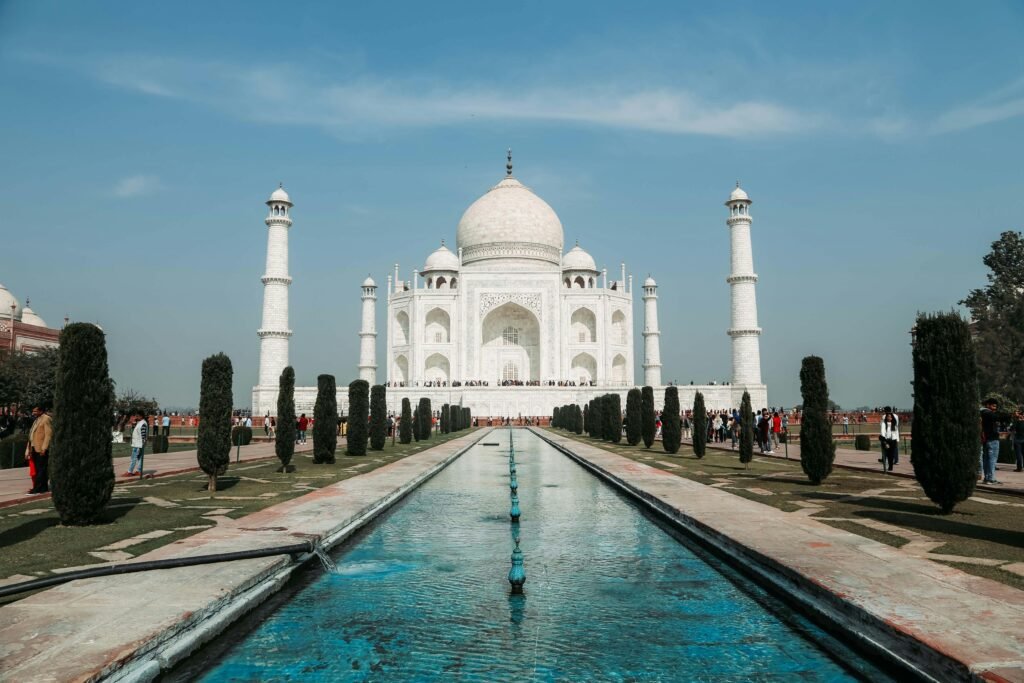Nestled on the serene banks of the Yamuna River in Agra, Uttar Pradesh, stands a monument that transcends mere architecture to embody a saga of eternal love and breathtaking artistry: the Taj Mahal. A UNESCO World Heritage Site and one of the New Seven Wonders of the World, this gleaming white marble mausoleum is more than just a structure; it’s a profound cultural icon, a testament to India’s glorious past, and a beacon of human ingenuity.
The story of the Taj Mahal begins in the heart of a grieving emperor. Mughal Emperor Shah Jahan, consumed by sorrow after the untimely death of his beloved wife, Mumtaz Mahal, during the birth of their 14th child in 1631, vowed to build a mausoleum worthy of her memory – a monument that would defy time itself. For over two decades, from 1631 to 1653, an army of over 20,000 artisans, craftsmen, and laborers from across India, Persia, and Central Asia toiled tirelessly to bring Shah Jahan’s vision of paradise on Earth to life.
What emerged from their collective genius is a symphony in marble. The Taj Mahal is a masterpiece of Mughal architecture, a harmonious blend of Indian, Persian, and Islamic styles. Its design is characterized by its astounding symmetry, a concept deeply ingrained in Islamic aesthetics, symbolizing balance and divine order. The central mausoleum, built of pristine white Makrana marble that shifts hues with the changing light of day, is flanked by four elegant minarets, which are subtly tilted outwards – a brilliant architectural foresight to ensure they would fall away from the main tomb in the unlikely event of an earthquake.
Every inch of the Taj Mahal whispers tales of exquisite craftsmanship. Its surfaces are adorned with intricate floral motifs, geometric patterns, and calligraphic verses from the Quran, created using the painstaking pietra dura technique. Precious and semi-precious stones like lapis lazuli, jade, crystal, turquoise, and amethyst are meticulously inlaid into the marble, creating dazzling mosaics that glitter in the sunlight. The main dome, a bulbous form often compared to an onion, crowns the structure, providing a sense of grandeur and ethereal lightness. Inside, the octagonal main chamber houses the beautiful cenotaphs of Mumtaz Mahal and Shah Jahan, intricately carved and surrounded by a delicate marble screen.
Beyond the mausoleum itself, the entire complex is a marvel of thoughtful design. A vast charbagh (four-part Persian garden), symbolizing paradise, stretches out before the main structure, divided by long reflecting pools that mirror the Taj Mahal, creating a breathtaking illusion of infinite beauty. The grand red sandstone gateway, adorned with white marble inlays and calligraphy, provides a dramatic entrance, framing the first awe-inspiring glimpse of the monument.
The Taj Mahal is more than just a monument of love; it is a profound symbol of India’s historical prowess. During the Mughal era, India was a flourishing center of art, architecture, science, and trade, reflecting its status as a significant global power. The sheer scale, resources, and artistic talent mobilized for the Taj Mahal’s construction underscore the immense wealth and sophisticated cultural achievements of the Mughal Empire. It stands as a powerful reminder of a time when India’s influence resonated far beyond its borders.
Today, the Taj Mahal continues to captivate millions of visitors annually, drawing them from every corner of the globe. It is a place where history breathes, where a love story endures, and where the echoes of a glorious past resonate with every step. To witness the Taj Mahal is to experience a piece of eternity, a testament to the enduring power of human emotion and artistic excellence, truly making it a crown jewel in India’s rich and vibrant legacy. Sources

